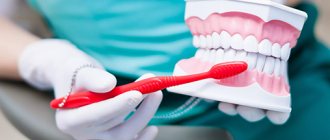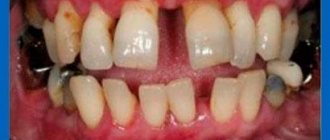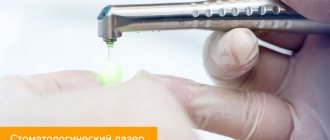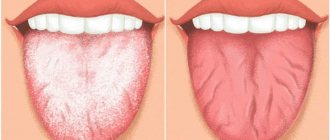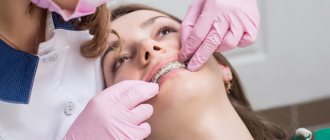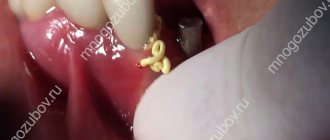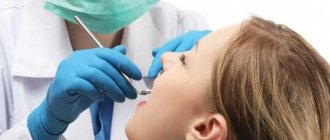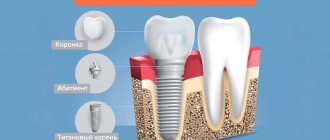- Work examples
- Questions and answers
- Stock
- Reviews
Normally, periodontal pockets do not exceed 3 mm, but due to gum problems, especially periodontitis, the space between the tooth and gum increases. The number of bacteria grows in it, pieces of food get stuck, as a result of which inflammation intensifies and the pocket grows larger. In such cases, an integral component of treatment becomes curettage of the periodontal pocket, or cleaning of the periodontal space, including the removal of dental and subgingival calculus, decay products, damaged tissue, other deposits, etc., as well as replenishment of bone tissue if it becomes insufficient (this problem becomes relevant as the disease progresses).
When to do gum curettage?
Indications for curettage of periodontal pockets are: 1) the presence of chronic generalized periodontitis, 2) local form of periodontitis. In both cases, periodontal pockets will appear along the surface of the tooth roots, the formation of which is associated with the resulting destruction of the dentogingival attachment (i.e., the attachment of the marginal gum to the neck of the tooth).
Destruction of the periodontal attachment in chronic generalized periodontitis occurs against the background of irregular oral hygiene, which contributes to the deposition around the necks of teeth - soft microbial plaque and hard tartar. Microorganisms in the composition of dental plaque trigger an inflammation process in the gums, which at the first stage is manifested by swelling and redness of the gums, bleeding when brushing teeth. Already during this period, gradual destruction of the periodontal attachment begins (with the formation of periodontal pockets).
Chronic generalized periodontitis –
1) Formation of periodontal pockets –
As soon as the periodontal attachment is destroyed, so-called “periodontal pockets” are formed between the gum and tooth. At first they are relatively small. Shallow periodontal pockets up to 4.0 mm deep correspond to mild periodontitis, and closed curettage may be indicated for precisely such patients (to prevent the progression of periodontitis).
Periodontal pockets are localized between the gum and the root of the tooth (Fig. 2). One wall of the pocket is the surface of the tooth root, on the surface of which microbial plaque and subgingival tartar are attached. The other wall is the inner surface of the unattached gum, which is covered with pathological epipelium and granulations. Thus, the typical contents of a periodontal pocket are dental deposits, granulations, and pathological epithelium.
Scheme of the structure of the periodontal pocket -
As we said above, in the absence of treatment, the depth of the pockets gradually increases. This occurs due to the destruction of the bone plate around the tooth, as well as periodontal fibers, due to which the tooth root is firmly attached to the bone. This gradual process inevitably leads to the appearance of tooth mobility, the increase in the degree of which in the future will be directly related, among other things, to the continuing increase in the depth of periodontal pockets.
2) Destruction of bone tissue around the tooth –
As was seen above in Fig. 2, the periodontal pocket “grows” deeper due to the destruction of periodontal fibers between the root surface and the bone plate, which also leads to the destruction of the bone graft itself (alveoli). Moreover, it should be noted that bone tissue does not simply disappear without a trace, but is replaced by the so-called inflammatory granulation tissue, which contains a large number of microbial cells, osteoclasts, etc. On an x-ray, the absence of bone around the teeth looks like this (Fig. 3b).
Clinical situation No. 1 –
Next, in Figures 4-6, you can see exactly what a deep periodontal pocket looks like under the gum in the interdental space between the canine and premolar in the lower jaw. As we can see from the outside, the gums look quite healthy, and only on an x-ray (Fig. 5) can we see a slight darkening between the roots of the teeth, indicating the presence of destruction of bone tissue. But we have a completely different look after the gums are detached and granulations are cleaned out of the pocket between the teeth (Fig. 6).
In Fig. 6 we see a deep bone defect of a large volume, as well as subgingival calculus on the surface of the tooth root (indicated by an arrow). Such deep periodontal pockets can no longer be sanitized using the closed curettage technique, which is carried out without gum detachment and therefore does not imply visual inspection of bone defects in the depths of the periodontal pocket (i.e., the doctor will simply blindly try to clean out what to clean out from under the gums).
Therefore, for pockets larger than 4.0 mm, only open curettage or flap surgery should be used. For medium and deep periodontal pockets, only these methods allow you to remove all granulations and dental deposits from under the gums, carefully scrape out the pathological epithelium from the inner surface of the gums, and also replant synthetic bone tissue in the area of deep bone defects (with the hope of partially restoring bone levels ).
Why is it impossible to do without curettage when treating periodontitis (in principle) -
With shallow periodontal pockets up to 4.0 mm, provided that you have good equipment (a good scaler, a Vector device) and the painstaking work of a periodontist, it is still possible to stop the progression of chronic periodontitis. The biggest challenge will be removing subgingival deposits from periodontal pockets, which is difficult to do even in shallow pockets, given that the work is carried out almost blindly.
When deep periodontal pockets have formed (more than 4 mm deep) and granulation tissue has formed at their depth, the process essentially becomes irreversible, despite any conservative local and general anti-inflammatory therapy. You can drink antibiotics, rinse your mouth with antiseptics, smear your gums with anti-inflammatory gels, irradiate your gums with a laser, but all this will be ineffective. Why?
- Firstly , it is impossible in principle to completely remove dental plaque from deep periodontal pockets. The fact is that the doctor inserts the ultrasonic attachment under the gum “blindly”, i.e. he makes movements without seeing what exactly is happening in the periodontal pockets. Therefore, some dental plaque necessarily remains in the pockets.
- Secondly , if deep periodontal pockets have formed, then in them, even after removal of dental plaque and anti-inflammatory therapy, conditions are created for the development of infection and further progression of periodontitis. The fact is that the pockets are filled with granulations, without surgical removal of which it is impossible to stop further destruction of the bone tissue around the tooth.
It turns out that you can still try to remove subgingival dental deposits and granulations in shallow pockets using ultrasonic cleaning and closed curettage techniques. It will be possible to do the same thing efficiently in deep pockets only by performing open curettage or patch surgery.
Indications and contraindications
One of the main reasons for a significant increase in gum pockets is periodontitis. This is a common disease that in advanced cases can lead to tooth loss. In turn, periodontitis often occurs for the following reasons:
- poor
oral hygiene (the most common problem) – plaque and tartar accumulate on the teeth, which lead to inflammation of the gums, the proliferation of bacteria and a further increase in the periodontal space; - other inflammations
in the oral cavity that spread to the periodontium, primarily gingivitis - inflammation of the gum tissue; - damage
due to injuries, the habit of cracking nuts with teeth, gnawing hard objects, etc.; - decreased immunity
, especially with a predisposition to periodontitis.
Thus, most often, treatment of gum pockets is necessary to eliminate periodontitis. Bleeding, inflammation, loose teeth, and bad breath should alert you. If these signs appear, be sure to contact a specialist. If you catch the first signs of periodontitis in time, curettage may not be necessary.
Sometimes such cleaning is required by the hole of an extracted tooth - if inflammation has begun in it or it does not heal correctly.
The procedure has relatively few contraindications. Temporary ones include acute respiratory and inflammatory diseases. Curettage is not always performed in cases of coagulation disorders and other blood diseases, uncompensated diabetes mellitus, etc.
How is closed curettage performed?
The purpose of the operation is to remove granulations from periodontal pockets, as well as those subgingival dental deposits that could not be removed using an ultrasonic scaler.
Disadvantages of the technique: curettage is carried out blindly, there is no visual overview of the surface of the roots, periodontal pockets - because of which granulations and dental deposits partially remain in their places. Scheme of closed curettage –
Closed curettage of periodontal pockets is performed under local anesthesia. Curettage of the gums with sharp curettes is accompanied by bleeding, which further complicates visual control. At the end of the operation, the wound surface is treated with antiseptics, and a protective gum bandage is applied for several days. In Fig. 7 you can see the instruments used to perform closed curettage. Laser surgery is also an option (see video below).
Closed curettage can be more or less effective only with shallow periodontal pockets (no more than 3-4 mm), i.e. with the mildest degree of periodontitis. For moderate and severe periodontitis, closed curettage (by reducing the volume of granulations) can only temporarily improve the condition of the gums, but this improvement will only be short-term, and periodontitis will definitely progress further. In some cases, closed curettage is performed as a preparatory step before open curettage or flap surgery.
The closed curettage technique is popular in dental clinics that do not have an experienced periodontist surgeon, and therefore the operation is performed by an ordinary general dentist (periodontist). These specialists have neither the skills nor experience in performing complex surgical interventions in the oral cavity, which include open curettage and flap operations. Therefore, the worst thing that can happen to you in this situation is that you will undergo a closed curettage (although with your pocket depth, more radical techniques have long been indicated for you).
In this case, the following consequences are possible - 1) you will get a short-term, but still improvement, 2) you will not get any results from the treatment in principle, 3) closed curettage can provoke an exacerbation of periodontitis, in which case you will get suppuration from the periodontal pockets and acceleration of inflammatory bone resorption.
Closed curettage using curettes and laser –
Video 1 shows scraping of granulations from a periodontal pocket in the area of only one tooth. As you can see, this use of curettes is quite traumatic and is accompanied by bleeding. In video 2, periodontal pockets are treated using a laser. In most cases, this will also be accompanied by slight bleeding (especially if the gums are loose and inflamed).
Causes of gum inflammation
Plaque is the main cause of gum inflammation: treatment should begin with the removal of dental plaque. The microorganisms that live in them release toxic substances that destroy tissue, resulting in an unpleasant odor from the mouth and bleeding from the gums. In addition, pathogenic microflora can lead to the development of other diseases.
Gum inflammation can also be caused by other reasons:
- mechanical damage;
- improper oral care;
- chronic diseases.
Open curettage of periodontal pockets –
The purpose of this operation is to remove all subgingival dental deposits, remove inflammatory granulation tissue from under the gums, eliminate periodontal pockets, and also stimulate the restoration of bone tissue (by means of “replanting” materials based on synthetic bone into bone defects).
Before the operation begins, careful preparation must be carried out - dental plaque must be removed, anti-inflammatory therapy must be carried out, and if there are indications, splinting of mobile teeth is carried out. The latter is very important, because Carrying out curettage without splinting mobile groups of teeth will lead to an even greater increase in their mobility, and will also increase the resorption of bone tissue around them.
Scheme of open curettage –
Description of the main stages of open curettage -
The operation is performed against the background of antibiotic therapy, under local infiltration and conduction anesthesia. During one operation, usually only one segment of 7-8 teeth is removed (usually this volume of intervention requires at least 2.5 hours of time). Next, we will focus on the main points of the operation.
1) Incision and detachment of flaps - open curettage means that after the onset of anesthesia, we make an incision in the gums around the necks of the teeth and peel off the mucoperiosteal flaps (on both sides of the dentition). Detachment of flaps from the necks of teeth and bone will allow us to expose the surface of the roots and bone tissue defects. Thus, we will obtain visual control over periodontal pockets and subgingival dental plaque (Fig. 9).
Clinical case No. 2 (Fig. 8-12) –
2) Removal of granulations and bone grafting – removal of granulation tissue is carried out using sharp curettes (in combination with an ultrasonic scaler or laser). The scaler softens granulations well and makes it easy to scrape them out of all the gaps and lacunae of bone tissue, as well as polish the root surface, removing a layer of necrotic cement from it. Next, antiseptic treatment of the wound is carried out. Next, chemical modification of the root surface is carried out, for example, with a suspension of tetracycline.
Next, the bone defects are filled with bone material, and ideally covered with special membranes. Bone grafting is effective precisely in the presence of deep periodontal pockets (when there is vertical resorption of bone tissue). If inflammatory bone resorption against the background of periodontitis occurs evenly and horizontally, bone grafting will not allow for an increase in bone volume. As a continuation of clinical case No. 2, you can see in this patient a partial restoration of bone volume in the interdental space (Fig. 11).
3) Suturing – sutures are placed in the area of the interdental papillae. At the end of the operation, a protective gum bandage is also applied, which will protect the operation area and promote speedy healing. Sutures are removed 10 days after surgery.
Open curettage: video
Rehabilitation period
Depending on the type of procedure, after it is performed the patient may feel mobility of the teeth, their increased sensitivity, swelling may appear, etc. With the closed version, most of the consequences go away within 10-14 days; with the open version, recovery takes a little longer. Increased sensitivity can last the longest – up to several weeks.
In order for healing to be as fast and problem-free as possible, patients should adhere to the following recommendations:
- immediately after the procedure you should refrain from eating
for at least 2 hours; - While healing is underway, it is better to avoid dishes that irritate tissues - too cold/hot, sour, spicy; at first, you should give preference to soft food
, especially with open surgery; - it is necessary to rinse your mouth
with disinfectant solutions according to the doctor’s recommendations; - On the first day after the procedure, it is better not to brush your teeth with a brush
or toothpaste; then, until complete healing, use a brush with soft bristles; - For the open option, the same recommendations apply as for other types of surgical intervention - in particular, minimizing physical exertion
and excessive shaking so as not to disturb the healing tissue.
If you are interested in closed or open curettage of teeth in Moscow and the region, contact the specialists of our clinic. We are distinguished by the use of the most modern technologies, a staff of highly professional dentists, European service delivery and their affordable prices. Sign up for a free consultation and your doctor will create the best treatment plan for you.
Flap surgery on the gums for periodontitis –
Flap surgery on the gums allows not only to remove all subgingival dental plaque, but also to remove inflammatory granulation tissue from under the gums. It allows, in principle, to eliminate periodontal pockets, and also, in some cases, to stimulate partial restoration of bone volume (in vertical bone defects). The difference between flap surgery and open curettage is that the incision during flap surgery is made 1-1.5 mm from the edge of the gum (24stoma.ru).
Then this 1.5 mm strip of gum, which wraps around the necks of the teeth, is simply removed. Firstly, this allows us to reduce the size of the flaps (gum size), because with severe bone resorption and after removing a large number of granulations, excess gum will be observed. We will not have enough underlying tissue volume to stretch the gum back to the necks of the teeth. That is, as a result, we will receive partial exposure of the roots of the teeth, but at the same time, periodontal pockets between the gums and the roots of the teeth will be completely absent. And this is the most important thing if we want to stop the progression of periodontitis.
The decrease in gum level after surgery can be somewhat reduced if synthetic bone tissue preparations are used for grafting into bone defects. The effect will be even better if special bioresorbable membranes are also used. At one time, the operation is performed on a segment of no more than 6-8 teeth, and takes at least 2.5 hours. This is a complex procedure that requires good surgical skills.
Carrying out flap surgery (animation and video) –
TOP most popular methods of professional teeth cleaning
Laser teeth cleaning
– a non-contact method of hygiene, in which the dentist directs a laser beam at each tooth, the process of destroying water molecules in deposits occurs, and the stone is neutralized.
Air Flow teeth cleaning
– a gentle method in which plaque and deposits are removed with a jet of finely dispersed mixture. This composition includes water and abrasive microparticles of soda. With the help of preventive teeth cleaning Air Flow, you can remove soft plaque and mineralized particles from the surface of the teeth, from the interdental space, and the subgingival area. At the same time, tooth enamel becomes lighter by two to three tones.
It is important! Tooth sensitivity (when it is not caused by dental diseases) is not a contraindication for Air Flow. On the contrary, after the procedure, the teeth become less sensitive to external irritants, and a feeling of fresh breath appears.
Scaling
– professional ultrasonic dental cleaning, in which plaque and deposits are destroyed due to the influence of ultrasonic waves. Vibrations contribute to the natural destruction of plaque, the stone is removed from the surface of the teeth and even subgingival pockets.
Mechanical professional toothbrushing
– carried out using hooks and brushes, usually used in tandem with the methods listed above, when deposits need to be cleaned from hard-to-reach places. Cleaning is performed by a device that emits vibration waves.
Flap surgery and curettage: price 2021
So how much does curettage of periodontal pockets cost in mid-price clinics in Moscow? For closed curettage, the price will start at an average of 700 rubles per tooth. Carrying out closed curettage with a laser will be slightly cheaper and will cost from 500 rubles per tooth.
The cost of open curettage for a segment of 6-7 teeth will be about 14,000 rubles (including the cost of economy-class bone material). The cost for each tooth starts from 1,500 rubles, but this price does not include the use of bone material. As for flap surgery, a segment of 6-7 teeth will cost you about 18,000 - 20,000 rubles, taking into account the cost of economy-class bone material.
When to see a doctor?
If inflammation of the gums near the tooth starts and treatment is not carried out in a timely manner, the teeth become exposed, become loose, begin to crumble and fall out. In this case, you must immediately contact a periodontist to avoid tooth loss.
You need to visit a doctor if:
- gumboil or fistula has formed on the gum;
- gums are swollen (gingival recession);
- the teeth began to loosen;
- gums bleed;
- dental plaque has appeared;
- unpleasant odor from the mouth.
If inflammation of the gums under the prosthesis begins, dental treatment will have to begin with the removal of the prosthesis.
Treatment with folk remedies
Many sources write about all kinds of folk remedies for the treatment of periodontal disease. Some techniques (rinsing with tincture of oak bark, walnut leaves, calendula or chamomile) can indeed be recommended by a doctor, but only as an additional element of complex treatment. It is important to understand that periodontal disease is considered a disease that is almost impossible to get rid of completely, so do not self-medicate under any circumstances - there is a high chance of only aggravating the situation. In severe stages of periodontal disease, tooth loss occurs, and the only option is their removal and removable dentures.
Recommended Dentists
Ilchenko Liliya Mikhailovna
Dentist therapist, periodontist, surgeon. 20 years of experience. She graduated from the Moscow State Medical Institute (MGMSU), clinical residency in surgical dentistry.
- Schedule
- Make an appointment
Novoselova Elena Nikolaevna
Dentist therapist, periodontist, orthopedist. 25 years of experience. Graduated from KSMI, residency at ChLG, Moscow.
- Schedule
- Make an appointment
Attention! You can lose your teeth!
Diseases of the periodontal tissues are much more likely than caries to cause tooth loss! Therefore, it is extremely important to carry out the necessary medical manipulations on time in order to exclude further development of the disease and stop the inflammatory process in the initial stage.
The PROFI-Dent clinic provides a full range of services in the field of periodontology. Our specialists successfully treat:
- inflammation and bleeding;
- gingivitis;
- periodontitis;
- periodontal disease;
- tissue injuries from the edges of crowns and fillings;
- periodontitis;
- stomatitis and other pathologies of the oral mucosa.
Treatment of dental gums at the PROFI-Dent clinic is comprehensive and includes both local and general therapy, aimed not only at relieving symptoms, but at eliminating the immediate cause of the pathological process.
Effective treatment of gum diseases
Before starting treatment, the doctor conducts a comprehensive examination of the patient to identify the presence of other diseases and get rid of them. If no diseases are detected, then he will turn to periodontal probing to choose the right methods and ensure quality treatment of stomatitis.
Periodontists use modern equipment in their work to cure gum disease: the treatment is painless, quick and high quality. After which the patient will not have to cover his mouth to hide existing problems: he will be able to smile from ear to ear, exposing his snow-white teeth to everyone.
But treatment of periodontitis will be effective only if a person properly cares for the oral cavity: brushes his teeth daily using medicated pastes and massages his gums.
